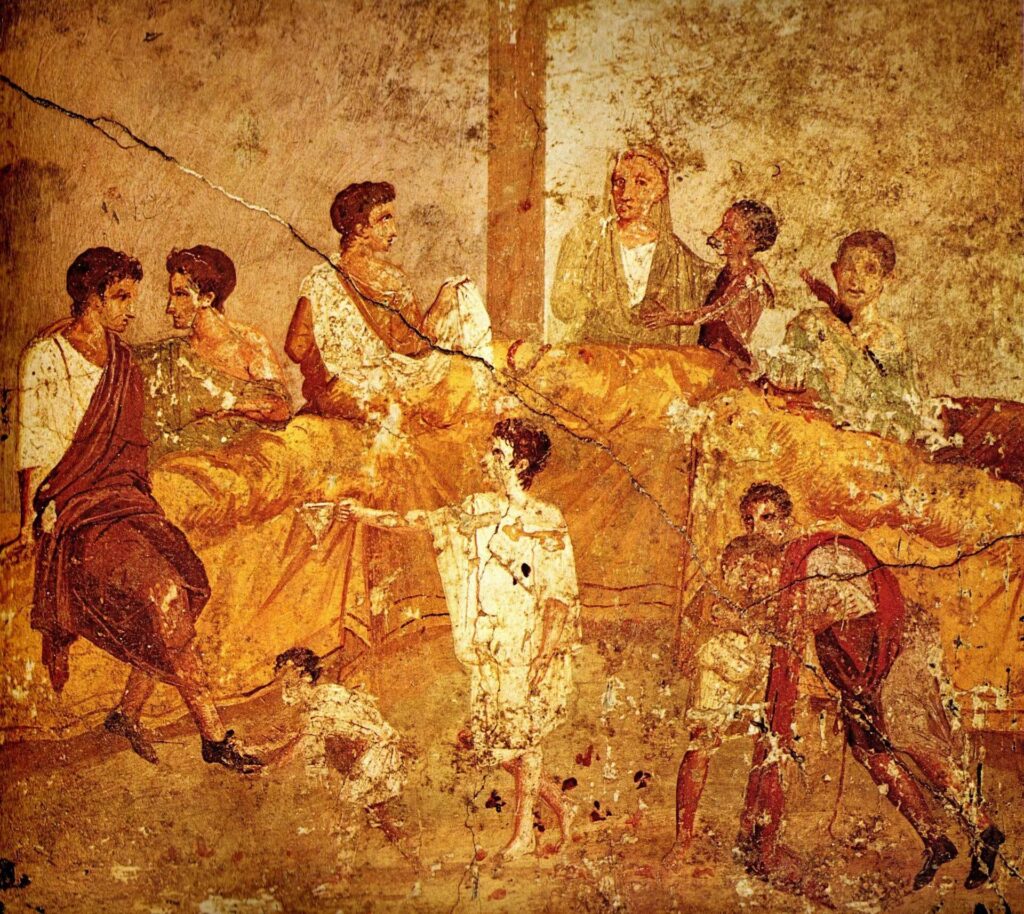Cannabis has a long and interesting history, but most people do not know much about how it was used in ancient Rome. The evidence that survives comes mainly from a few old writings, since many objects from that time have been lost. Even in those texts, cannabis is not always directly explained, as people of that era already knew what it was and how it was used.
The Romans learned about the plant from earlier cultures and used it in several ways. They recognized both wild and domesticated types, and used cannabis to make things like rope, sails, baskets, and clothes. Writers of the time also described some of its medical uses and noted a few effects that might sound similar to what people talk about today.
Key Takeaways
- Ancient Rome used cannabis for medicine and making everyday items.
- Many details of its recreational use were not written down.
- Roman culture valued moderation and did not openly discuss cannabis in religion.
Early Roots Of Cannabis And Its Expansion Worldwide
Early Use In China And Movement Across Regions
The first recorded mention of cannabis goes back to 2,800 B.C.E. in China. It was not limited to one area—after its beginnings in East Asia, cannabis traveled to India, the Middle East, Greece, and finally Rome.
People used cannabis to help with several health problems, including arthritis, asthma, depression, pain, and other conditions. They also made products like hash or resin by pressing the plant, and sometimes brewed it like tea or inhaled it after heating.
Ways Cannabis Was Used:
| Method | Description |
|---|---|
| Pressed (hash/resin) | Collected sticky sap for use |
| Tea | Soaked in water and drunk |
| Smoked/Inhaled | Heated and inhaled for effects |

Over time, people began recognizing the different strains of cannabis and started using the plant for varied needs.
Cannabis In Ancient Rome
By the first century, Romans had enough knowledge of cannabis to tell apart wild and grown types—what we now call marijuana and hemp. Medical knowledge from Greece influenced Roman understanding, especially through texts like those by Dioscorides, who listed two types: one used to help with earaches and as birth control, and another to reduce swelling and joint pain when applied to the skin.
Roman author Pliny the Elder described cannabis as useful for making ropes, baskets, shoes, and other textile goods. Romans seemed to value cannabis more for its practical uses rather than for recreation or religious purposes. While there are mentions of its possible effects in literature, such as being called the “laughing weed” or mixed with wine for stronger results, most evidence points to industrial and medical use.
Examples Of Cannabis Uses By Ancient Romans:
- Rope and boat sails
- Bags and clothing
- Pain and inflammation relief
- Possibly as a treatment for earaches and digestive problems
Even though recreational use is known from other cultures, the Romans rarely talked about it publicly due to their focus on modesty and restraint. Cannabis did appear in symbolic ways, such as in dreams, but did not hold a strong place in mainstream religious ceremonies.
Ancient Roman Uses of Cannabis in Medicine
Greek Roots and Dioscorides’ Role
Medical practice in ancient Rome was shaped by Greek knowledge. Dioscorides, a Greek physician, wrote an extensive medical text that listed cannabis among hundreds of other substances. He described two types of cannabis: one type was used to help with ear pain and as a form of birth control when eaten. The other was boiled and put on the body to help with swelling and sore joints.
Table: Dioscorides’ Notes on Cannabis
| Type of Cannabis | Application | Reported Benefit |
|---|---|---|
| Domesticated (emeros) | Eaten | Reduced ear pain, birth control |
| Wild (agria) | Boiled & applied | Reduced swelling, helped joints |

Early Roman Medical Practices Documented by Pliny
Pliny the Elder, a Roman writer, also mentioned cannabis in his work about nature. He noted that eating the seeds could cause impotence and claimed the boiled root helped joint pain. Pliny also said that juice from the plant could be used for animal health and might remove insects from the ears.
List of Cannabis Uses from Pliny
- Seeds: Claimed to lower sexual function
- Boiled Root: Eased joint cramps
- Plant Juice: Used for animal digestion and ear care
Common Ailments Treated with Cannabis
Cannabis in Rome was mostly used for health problems that are still familiar today. Some of the main conditions it treated were:
- Arthritis
- Earaches
- Swelling and pain in joints
- Digestive issues (in animals)
These treatments were usually not for pleasure but to help with daily health problems. Most often, cannabis was valued for its practical uses and its role in making products, but it did have a place in Roman medicine as well.
Everyday Products and Industrial Roles of Cannabis
Fabrics, Ropes, and Useful Items
Cannabis was prized for making strong materials in the ancient world. People turned its fibers into ropes, boat sails, baskets, shoes, and clothing. They used these items daily, showing a clear preference for practical instead of recreational uses.
Common Products Made from Cannabis Fiber:
| Product Type | Use |
|---|---|
| Rope | Boats, lifting, tying |
| Cloth | Clothing, bags, shoes |
| Baskets | Carrying goods |
| Sails | Ships and boats |
Writers from Greece and Rome noted how effective cannabis was for making tough ropes and nets. It was often called “a plant of considerable use” because of its everyday importance.
Differences by Region and Fiber Quality
The quality of cannabis fiber changed depending on where it was grown. Some regions grew plants that made better ropes and nets. For example, one area was famous for cannabis ideal for hunting nets.
Factors Affecting Hemp Quality:
- Where the plant was grown
- How it was picked and dried
- Methods of cleaning and peeling
Writers described three levels of fiber quality. Good fiber was chosen for special uses, while lesser types were made into everyday objects. Regional differences made some products stronger and longer lasting.
Social and Mood-Altering Purposes
Mentions in Historical Writings
Texts from the ancient world, especially Greece and Rome, sometimes reference cannabis and its effects. For example, old Greek comedy describes people using cannabis seeds for their mood-changing properties. The historian Herodotus wrote about Scythian nomads using cannabis in a way that made them very happy. Roman authors, including Pliny the Elder, also mention cannabis. He called it a “laughing weed” and even suggested it could be added to wine for stronger effects.
| Ancient Figure | How Cannabis Was Described or Used |
|---|---|
| Herodotus | Thrown on coals, caused joyful “howling” |
| Ephippus (comic) | Cannabis seeds used for getting high |
| Pliny the Elder | “Laughing weed,” sometimes added to wine |
| Artemidorus | Mentioned in dream interpretation |
Views on Having Mind-Altering Experiences
In Roman society, moderation and self-control were important values. People were expected to show restraint in public and take their social roles seriously. Using substances just to get intoxicated was not usually discussed openly. It was seen as something that did not fit with the image Romans wanted to show. Even if some group used cannabis to relax or change their mood, these actions were rarely talked about in writing.
Key Values:
- Modesty
- Temperance
- Respect for tradition
Romans believed public behavior should reflect these traits, so recreational use of cannabis was a topic left mostly unspoken in official texts.
Everyday Cultural Habits
The day-to-day use of cannabis was likely shaped by unwritten rules rather than clear laws or statements. There is little written evidence of open recreational use, but people may have enjoyed cannabis in private or in informal settings. Social customs made it more common to talk about practical uses, like making rope or fabric, instead of its mind-altering qualities.
- Clothing, ropes, and baskets were common products made from cannabis.
- Recreational use may have happened in private, away from the spotlight.
- Cannabis sometimes appeared as a symbol in dreams, suggesting some personal or cultural significance.
Note: Much about how people used cannabis for fun or mood changes was not written down and survives mainly through hints and indirect references in old stories and texts.
Cannabis in Roman Beliefs and Meanings

Traditional Views and Moral Standards
Romans mostly saw cannabis as a useful plant, especially for making rope, nets, and clothing. They valued self-control, modesty, and stability in their culture, and these values influenced both daily life and religion.
Because of these traditions, Romans kept a cautious distance from anything that might change the status quo or threaten their sense of order. Using cannabis in a religious ceremony would not fit with their conservative attitudes unless it had a clear purpose tied to their ancient practices.
Here is a simple summary:
| Aspect | Roman Perspective |
|---|---|
| Main Use of Cannabis | Practical (textiles, ropes, nets) |
| Attitude Toward Change | Suspicious, preferred tradition |
| Religious Use | Not clearly present or common |
Plant Meanings and Dream Interpretation
Although cannabis was not central in Roman rituals, it held some symbolic value, especially in dream interpretation. In the 3rd century, Artemidorus mentioned that seeing cannabis fiber in a dream was different from dreaming about its flower. Each dream symbol could have its own special meaning.
Cannabis was sometimes called the “laughing weed” and was known to be mixed into wine to make it stronger. While some people guess that cannabis had a big spiritual role, there is no strong proof that it was important in traditional Roman temple ceremonies.
Key points:
- Dreaming about parts of the cannabis plant had unique meanings.
- Some Romans knew cannabis could be intoxicating, but this was not celebrated in religion.
Legacy And Lasting Impact
Cannabis influenced many aspects of Roman society, from medicine to daily life. Romans used cannabis to create useful goods like ropes, baskets, shoes, and boat sails. The plant’s fibers were valued for their strength and durability, making them important for practical needs.
In medicine, both Greek and Roman writers described cannabis as helpful for easing joint pain, reducing swelling, and even treating earaches. Some writers explained differences between wild and cultivated types of cannabis, linking each to different uses. For example, kannabis emeros was recognized for making sturdy ropes, while kannabis agria was used in remedies.
Although there is some mention of people using cannabis in food, drink, and other ways that might seem recreational, records do not show widespread or open use for pleasure. Roman values, like modesty and self-control, likely shaped what was written and what was practiced in private.
| Use | Example |
|---|---|
| Textiles | Ropes, baskets, clothing, boat sails |
| Medicine | Arthritis, ear pain, swelling |
| Symbolism | Sometimes in dreams or cultural meanings |
Most evidence points to cannabis being more important for its practical uses than for religion or entertainment. The plant’s legacy continues to be felt through its lasting impact on medicine and everyday tools.
